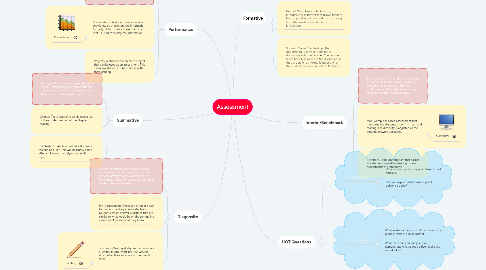Assessment
by Megan Robinson


1. Performance
1.1. This type of assessment has student perform a specific task in order to assess their knowledge.
1.2. Presentations: A student can show what they know by presenting the information formally. Often times a PowerPoints or Prezi is used to display the information.
1.2.1. Presentation
1.3. Projects: A student can create a project that can be used as an assessment. This can allow students to be creative with their learning.
2. Summative
2.1. This type of assessment is used to get an overall understanding of what a student has learned at the end of a lesson or unit. This is a high-stakes assessment.
2.2. Chapter Tests: Students would take a test of their understanding of the chapter reading.
2.3. Unit Tests: Students would take this test at the end of a unit. This would usually come after a full week of studying a specific topic.
3. Diagnositc
3.1. This type of assessment would be given before instruction to measure what the students strengths and weaknesses are. The educator can then adjust instruction as needed based on the results.
3.2. Pre-Assessments: These are often in a quiz format and can be paper or electronic. Students would answer questions that are similar to what would be on the summative assessment to see what they know.
3.3. Journaling/Writing: A student can answer a provided prompt with informal writing about what they know about the specific topic.
3.3.1. Writing
4. Formative
4.1. Formative assessment is the informal process of assessing students to learn what they know and still need to learn. It allows the educator to give feedback and adjust instruction to fit the students needs. This is a low-stakes assessment.
4.2. Kahoot: This gives students a fun, interactive quiz format that allows them to be competitive but gives educators a way to gather evidence of student's knowledge.
4.3. Socratic Circles: Students get the opportunity to have a meaningful discussion with one another. The teacher is not heavily involved in the discussion so they are able to informally assess what the students understand about the topic.
5. Interim/Benchmark
5.1. These assessments are done throughout the year and are used to see where the student is at and to see if they are understanding the material well enough to do well on future assessments.
5.2. Map: Computer based assessment that measures the students growth in math and reading. The difficulty is adjusted as the student answers questions.
5.2.1. Computer
5.3. I-Station: Computer program that assess the student's growth in reading. These assessments are interactive.
6. HOT Questions
6.1. Opening Questions
6.1.1. What is your opinion of good citizens? Bad citizens?
6.1.2. Can you explain what makes a good citizen so good?
6.2. Guiding Questions
6.2.1. What evidence can you find that shows why good citizens are so important?
6.2.2. What facts can you compile that demonstrate what a good citizen looks and sounds like?
6.3. Closing Questions (2)
6.3.1. What changes would you make in yourself to help yourself become the best citizen you can be?
6.3.2. What approach would you use to teach your peers about good citizenship?
